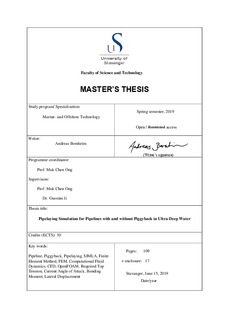| dc.contributor.advisor | Chen Ong, Muk | |
| dc.contributor.advisor | Ji, Guomin | |
| dc.contributor.author | Borsheim, Andreas | |
| dc.date.accessioned | 2019-10-08T09:11:21Z | |
| dc.date.available | 2019-10-08T09:11:21Z | |
| dc.date.issued | 2019-06-15 | |
| dc.identifier.uri | http://hdl.handle.net/11250/2620809 | |
| dc.description | Master's thesis in Offshore technology : subsea technology | nb_NO |
| dc.description.abstract | Pipelaying operations are pushing the boundaries of installation depth from midwater to ultra-deepwater. Parameters such as combined loading, top tension, and current loading must be investigated appropriately to ensure feasible operations. Until now, current loading effects have not been considered as an important factor for pipelaying operations. However, as modern ultra-deep pipelaying operations reach depths up to 4000 meters, there will be a considerable projected area for current-induced forces to act [1]. In recent years, the application of pipelines with direct electrical heating (DEH) cables has become conventional and is used in oil fields like Skarv, Tyrihans, and Lianzi. Lengths of these installations go up to 44km at depths over 1000 meters [2].
A numerical study has been performed for pipelines with and without piggyback, using the finite element method (FEM) software SIMLA. Pipeline-piggyback configurations have complex hydrodynamic force distributions which are dependent on pipeline inclination and angle of attack of the current. A new approach is developed for pipeline-piggyback-configurations by including body elements in the model to account for current induced hydrodynamic forces. The drag coefficients are defined in the command card “HYDROPRO”, accounting for the variation in the angle of attack of the current. To fully understand the pipeline-flow interaction, a series of two-dimensional numerical simulations was performed for singular pipelines and piggyback-solutions, using the open source Computational Fluid Dynamics (CFD) code OpenFOAM. Hydrodynamic forces are extracted separately for the pipeline and the piggyback cable; and the drag coefficients are obtained for the various angle of attack of the flow. CFD has not been used in combination with pipelaying simulations before. The CFD results give a good insight into the pipe/cable/flow interaction and provide reliable drag coefficients used in pipelaying simulation.
A series of simulations is performed for subsea pipelines of three diameters (20”, 28” and 30”) with and without piggyback. Furthermore, parameter studies are performed for scenarios with and without current loading at different angles of attack. The main findings are as follows:
• A new modelling technique for pipeline-piggyback-configurations is verified for modelling of current induced hydrodynamic forces.
• A new approach combining CFD and FEM to evaluate pipeline lay-ability is applied in the pipelaying simulation for complex configurations.
• Pipeline lateral displacement is significantly increased for a piggyback-configurations.
• Vessel top tension requirement increases when including current loads. | nb_NO |
| dc.language.iso | eng | nb_NO |
| dc.publisher | University of Stavanger, Norway | nb_NO |
| dc.relation.ispartofseries | Masteroppgave/UIS-TN-IMBM/2019; | |
| dc.subject | offshore teknologi | nb_NO |
| dc.subject | undervannsteknologi | nb_NO |
| dc.subject | piggyback | nb_NO |
| dc.subject | computational fluid dynamics | nb_NO |
| dc.subject | OpenFOAM | nb_NO |
| dc.subject | SIMLA | nb_NO |
| dc.subject | pipeline | nb_NO |
| dc.subject | lateral displacement | nb_NO |
| dc.title | Pipelaying Simulation for Pipelines with and without Piggyback in Ultra-Deep Water | nb_NO |
| dc.type | Master thesis | nb_NO |
| dc.subject.nsi | VDP::Technology: 500::Marine technology: 580::Offshore technology: 581 | nb_NO |
